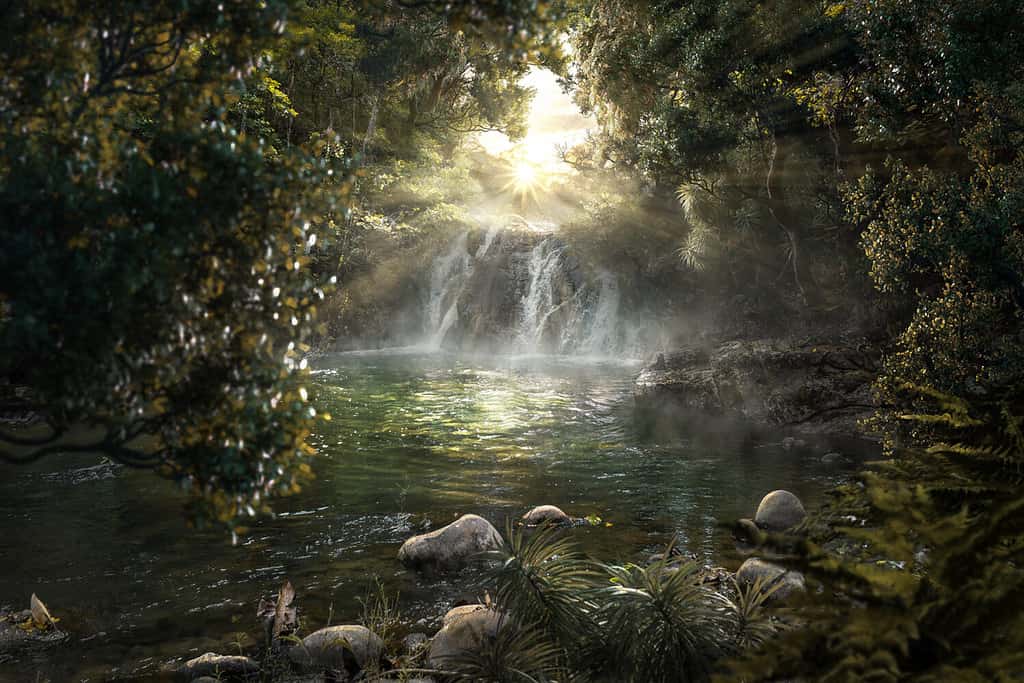The search for the Garden of Eden, the mythical paradise where humans originated, has been a long-standing quest. Many theories have emerged, and this article will explore some; however, the exact location remains uncertain, adding to the mystery of this elusive place.
Where is the Garden of Eden, According to the Bible?

One theory suggests that the Garden might have been located in what is now Iraq, as Genesis mentions it being in the east.
©lassedesignen/Shutterstock.com
According to Genesis 2 in the Bible, the Garden of Eden was a perfect paradise where humans lived in harmony with nature, free from disease, death, and hunger. Unfortunately, God banished Adam and Eve from the Garden after disobeying God’s command not to eat from the Tree of Knowledge of Good and Evil. Since then, humanity has lived in a fallen state, facing the world’s challenges.
Iraq
One theory suggests that the Garden might have been located in what is now Iraq, as Genesis mentions it being in the east. Two of the four rivers described (Tigris and Euphrates) are associated with the region. However, due to changes in the course of these rivers over time and the geological impact of the biblical flood, any evidence of its location might be buried under layers of sediment.
Africa
Another compelling theory places the Garden of Eden in Africa. Some scientists believe that the Kalahari Desert in Botswana could be the location, as genetic research suggests that humans share a common ancestry with people who lived in Africa around 150,000 to 200,000 years ago. The wetlands of the Kalahari Desert could have been the site where early humans resided before dispersing to other regions due to changing climate conditions.
Despite these theories and the progress made through groundbreaking research, the exact location of the Garden of Eden still needs to be determined. Based on available evidence, Africa is the most plausible place, but it is still speculative. Moreover, even if someone found the Garden, the biblical account suggests it is unreachable, guarded by cherubim with a flaming sword.
In conclusion, the quest for the Garden of Eden continues to captivate the imagination of many. While theories abound, definitive evidence remains elusive. Whether we will ever uncover its exact location is uncertain, but the journey of exploration and curiosity persists.
The Story of the Garden of Eden
The story of the Garden of Eden is a biblical narrative found in the book of Genesis. This is the first book of the Old Testament in the Bible. A summary of the story goes as follows:
In the beginning, God created the heavens and the earth. He formed Adam, the first man, from the dust of the ground and breathed life into him. This made him a living being. God then placed Adam in the Garden of Eden, a beautiful and bountiful paradise where everything was perfect and abundant. In the center of the Garden were two unique trees. It was the Tree of Life and the Tree of Knowledge of Good and Evil.
God gave Adam the responsibility to care for the Garden and its inhabitants. However, he also warned Adam not to eat from the Tree of Knowledge of Good and Evil. For doing so would bring death.
Feeling that it wasn’t good for man to be alone, God created Eve, the first woman. He made her from one of Adam’s ribs. Adam and Eve lived together in perfect harmony and bliss in the Garden of Eden.
One day, a cunning serpent, often associated with Satan, approached Eve. He deceived her by questioning God’s command and suggesting eating from the forbidden tree. The spent said it would make her wise like God. Tempted by the serpent’s words and desiring wisdom, Eve took a bite from the forbidden fruit. She then offered it to Adam, who ate it.

Tempted by the serpent’s words and desiring wisdom, Eve took a bite from the forbidden fruit. Then, offered it to Adam, who ate it.
©funstarts33/Shutterstock.com
Adam and Eve’s Punishment
As a consequence of their disobedience, their eyes opened, and they became aware of their nakedness. They felt shame and tried to hide from God’s presence among the garden trees.
God, being all-knowing, already knew what had happened. He confronted Adam and Eve about their actions. When questioned, Adam blamed Eve, and Eve blamed the serpent. God pronounced punishments for each of them.
The snake was cursed to crawl on its belly, and there would be enmity between the serpent and humanity. Eve was to experience pain in childbirth and would be subject to her husband. Adam’s punishment included toiling on the ground for food and facing hardship and mortality.
God banished them from the Garden of Eden to prevent Adam and Eve from eating from the Tree of Life. He also banished them to live forever in their fallen state. He placed Cherubim with a flaming sword at the Garden’s east to guard the way to the Tree of Life.
The photo featured at the top of this post is © lassedesignen/Shutterstock.com
Thank you for reading! Have some feedback for us? Contact the AZ Animals editorial team.







